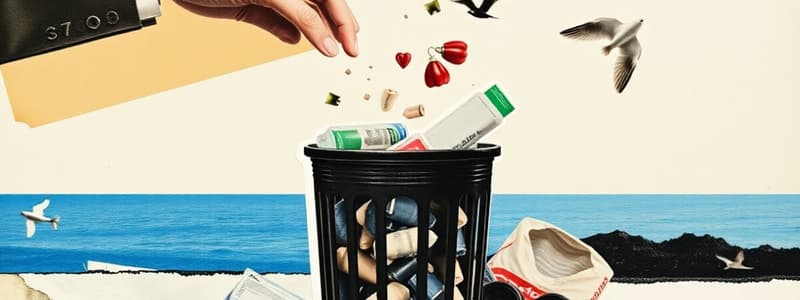Podcast
Questions and Answers
Which of the following is NOT a form of product disposal?
Which of the following is NOT a form of product disposal?
- Upcycling it
- Recycling it
- Throwing it away
- Using it continuously (correct)
Divestment rituals are only applicable when throwing products away.
Divestment rituals are only applicable when throwing products away.
False (B)
What is e-waste?
What is e-waste?
E-waste refers to electrical equipment or electronic devices that are intended for reuse, resale, salvage, recycling, or disposal.
The ________ rituals include actions such as washing and wrapping items before they are given away.
The ________ rituals include actions such as washing and wrapping items before they are given away.
Match the divestment ritual with its description:
Match the divestment ritual with its description:
What percentage of grocery products purchased in the US are never used?
What percentage of grocery products purchased in the US are never used?
Environmental recycling is a minor aspect of post-consumption waste management.
Environmental recycling is a minor aspect of post-consumption waste management.
Name two platforms that facilitate consumer-to-consumer exchanges.
Name two platforms that facilitate consumer-to-consumer exchanges.
Flashcards
Divestment Rituals
Divestment Rituals
The practices consumers go through when getting rid of items they used to value. This includes taking photos, storing them away, or cleaning them before disposal.
Upcycling
Upcycling
Reusing a product to create something of equal or greater value than the original. For example, making a new bag out of an old t-shirt.
Reselling
Reselling
A common practice that involves buying and selling items, such as clothes, furniture, and electronics, through websites or apps.
E-Waste
E-Waste
Signup and view all the flashcards
Iconic Transfer Ritual
Iconic Transfer Ritual
Signup and view all the flashcards
Transition-Place Ritual
Transition-Place Ritual
Signup and view all the flashcards
Cleansing Ritual
Cleansing Ritual
Signup and view all the flashcards
Product Disposal
Product Disposal
Signup and view all the flashcards
Study Notes
Product Disposal Practices
- Product disposal encompasses various actions beyond simply discarding items, including never using, recycling, upcycling, reselling, or exchanging.
- Divestment rituals are practices consumers employ when relinquishing possessions. These rituals help detach from items prior to disposal or resale.
- Three main types of divestment rituals exist: Iconic transfer rituals (e.g., taking pictures of items before discarding them), Transition-place rituals (e.g., storing items in out-of-the-way locations), and Cleansing rituals (e.g., cleaning, ironing, and wrapping items before storage or re-gifting).
Consumer Waste Concerns
- A significant portion of purchased grocery products in the US (12%) are never used (Solomon, 2014).
- E-waste, electronic equipment destined for disposal, presents a significant environmental problem.
- In 2009, the US sold over 438 million electronic products and 2.4 million tons were ready for end-of-life management (EPA, 2016).
Environmental Recycling
- Consumers engage in recycling driven by environmental concerns, frugality, anti-consumption, economics, or politics.
- Recycling involves purchasing products from thrift stores, secondhand markets, and online platforms.
- Examples of such platforms include NeighborGoods, Gumtree, eBay, and Craigslist.
- Freegans are anti-consumerists who engage in "lateral cycling", often scavenging discards.
- "Dumpster diving" refers to salvaging items from waste containers as a form of reclaiming and re-using resources.
Upcycling
- Upcycling involves repurposing products into new items of equal or greater value.
- For example, sewing a shirt and skirt to create a dress.
- Another example of upcycling could be repurposing old furniture.
Studying That Suits You
Use AI to generate personalized quizzes and flashcards to suit your learning preferences.





